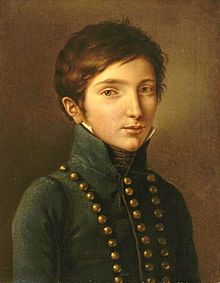Napoléon Louis Bonaparte
This article needs additional citations for verification. (August 2008) |
| Louis II | |
|---|---|
 | |
| King of Holland | |
| Reign | 1 July 1810 – 13 July 1810 |
| Predecessor | Louis I |
| Grand Duke of Berg and Cleves | |
| Reign | 3 March 1809 – 1 December 1813 |
| Predecessor | Joachim I |
| Regent | Napoleon |
| Born | 11 October 1804 Paris, First French Empire |
| Died | 17 March 1831 (aged 26) Forlì, Papal States |
| Burial | |
| Spouse | Charlotte Bonaparte |
| House | Bonaparte |
| Father | Louis I of Holland |
| Mother | Hortense de Beauharnais |
| Royal styles of Louis II of Holland | |
|---|---|
 | |
| Reference style | His Majesty |
| Spoken style | Your Majesty |
Napoléon-Louis Bonaparte (11 October 1804 – 17 March 1831) was King of Holland for less than two weeks in July 1810 as Louis II. He was a son of King Louis I and Queen Hortense. His father was the younger brother of Napoléon I, Emperor of the French, and ruled Holland from 1806 to 1810. His mother was the daughter of Josephine de Beauharnais, Napoléon's first wife. His younger brother, Louis-Napoléon, became Emperor of the French as Napoléon III.
Background[]
Napoléon Louis's brother, Napoléon Charles, died in 1807 at the age of four. On his death, Napoléon Louis became Prince Royal of Holland. It also made Napoléon Louis the second eldest nephew of Emperor Napoléon I, who at the time had no legitimate children, and he was his uncle's likely eventual successor. He lost this presumptive status on 20 March 1811 when his uncle's second wife, Marie Louise, gave birth to a son, Napoléon François Joseph Charles Bonaparte, who was styled the King of Rome and later the Duke of Reichstadt.
In 1809, Napoléon I appointed him as Grand Duke of Berg, a status he kept until 1813.
On 1 July 1810, Louis I of Holland abdicated his throne in favour of Napoléon Louis.[1] For the nine days between his father's abdication and the fall of Holland to the invading French army in July 1810, Napoléon Louis reigned as Lodewijk II, King of Holland.
When Napoléon I was deposed in 1815 after the Battle of Waterloo, the House of Bourbon was restored to the throne of France. Napoléon Louis fled into exile, but the Bonapartes never abandoned the thought of restoring the Napoleonic Empire.
On 23 of July, 1826 Napoléon Louis married his first cousin, Charlotte, who was the daughter of Joseph Bonaparte, eldest brother of Napoléon I. He and his younger brother Louis-Napoléon Bonaparte settled in Italy, where they espoused liberal politics and became involved with the Carbonari, an organization fighting Austria's domination of northern Italy.
On 17 March 1831, while fleeing Italy due to a crackdown on revolutionary activity by Papal and Austrian troops, Napoléon Louis, suffering from measles, died in Forlì.[2] Eventually, the Napoleonic Empire was restored by Napoléon Louis's younger brother, Charles-Louis, who became Napoléon III in 1852.
Napoléon Louis is buried at Saint-Leu-La-Foret, Île-de-France.
Arms[]

Coat of arms of Napoleon Louis Bonaparte as Grand Duke of Cleves and Berg

Coat of arms of Napoleon Louis Bonaparte as King of Holland
Gallery[]

Portrait by François Kinson, c.1810

With family and Emperor Alexander I of Russia at Château de Malmaison

Portrait by Félix Cottrau

Portrait with his father, Louis Bonaparte

Napoléon Louis in later years
References[]
| Wikimedia Commons has media related to Napoléon Louis Bonaparte. |
- ^ Foissy, M. (1830). La famille Bonaparte depuis 1264 (in French). Paris: Vergne. p. 101.
- ^ Bresler 1999, pp. 94–95
- House of Berg
- House of Bonaparte
- Dutch monarchs
- Princes of France (Bonaparte)
- Grand Dukes of Berg and Cleves
- People of the Kingdom of Holland
- 1804 births
- 1831 deaths








